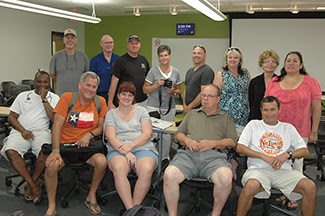
Criminal justice and forensic science teachers from school districts across the state recently participated in a forensic photography training offered by the Southeast Texas Applied Forensic Science facility.
Junior high and high school teachers learned the art and science of forensic photography at a three-day training offered by the Southeast Texas Applied Forensic Science Facility.
The training was led by Sergeant Susan Monroe, who has worked as a forensic photographer and crime scene investigator for Sheriff Offices in Los Angeles County in California and Harris, Kaufman and Smith counties in Texas. She is currently the training coordinator and a crime scene investigator on major crimes for the Smith County Sheriff’s Office.

The three day class was taught by Sgt. Susan Monroe, a forensic photographer and crime scene investigator with the Smith County Sheriff’s OfficeThe class included criminal justice and forensic science teachers from across Texas. Monroe shared lessons learned from processing hundreds of crime scenes to provide these instructors with real life experience on what to photograph and how to photograph evidence in police investigations. In addition to providing instructions on how to use digital cameras, including aperture, shutter speed, and ISO, participants learned the process of photographing a crime scene to help tell the story for jurors in a courtroom.
“You want to capture the scene,” said Monroe. “Evidence can be photographed to preserve it and to show its location and condition. It’s not just a photograph, it tells a story.”

By adjusting aperture and shutter speed, teachers learned how to differentiate black and white jacks on a white background.To help illustrate the capacity of the camera, Monroe provided several fun, inexpensive exercises that students could do in class to learn about long, mid-range and close up shots, depth of field, motion and how to stop motion, and how to shoot in light and dark conditions. The lessons utilized large, black and white chess pieces or 3D cardboard letters to show focus and depth of field and pinwheels, hula hoops and lawn darts to demonstrate how to show motion and stop motion in a picture. The class also practiced exposures by waving a flash light to illuminate a room at night.

Using lawn darts, teachers try to capture motion in mid-air.Teachers also learned the meticulous steps needed to photograph a crime scene so that evidence can be presented to a jury. They got to practice those steps and critique photographs in a mock crime scene, which included a murder victim, weapon, blood spatter, footprint and hand prints, a scene that can be replicated for their high school students.

The “body” of a murder victim is photographed from all angles. To process a crime scene, a crime scene investigator has to first interview the responding officer to find out about the situation and the ways in which the crime scene was disturbed. An investigator will do a walk-through of the scene, taking great care not to disturb any evidence and to identify what needs to be collected.
Forensic photography begins outside the scene by taking long distance shots that shows the location of a crime, such as the nearest street corner, and progressively gets closer to the location, showing nearby features or specific addresses. The photography should include long, medium and close-up views of the scene.

A footprint left behind by a suspect was photographed in a classroom using a light to show detail and texture. At the scene of the crime, the investigator photographs the entire room or location first, taking views from each corner and sides of the location to document the scene as it was found. All entries or exits to the site are also photographed.
Following the overall photos, each piece of evidence is photograph at long, mid and close-up ranges to show its location at the scene and its proximity to the victim or other evidence. Later, the evidence is photographed again with markers and measurement tools to show the size and proximity to other objects in the scene. A diagram of the scene should also be made to keep track of the evidence.

A sketch of the crime scene makes it easier to pinpoint evidence at the scene. All photos must be taken in order and none can be erased. Those photos also have to be stored and documented as evidence in the case, and access to them has to be carefully documented to be admissible in court.
“Jurors want to see photographs. They really want to see a video of the crime occurring!” said Monroe.
Many students are interested in crime scene investigations because of shows like CSI, NCIS and others. However, the real work of forensic investigators is nothing like what is depicted on TV, Monroe said.
“Our jobs are not exciting, in fact they could be considered boring, tedious and meticulous, and there is nothing fun about it,” Monroe said. “I do this for no other reason than to bring closure to a victim’s families, whether the death was natural or the result of a homicide. If they can sleep better at night, I have done my job.”